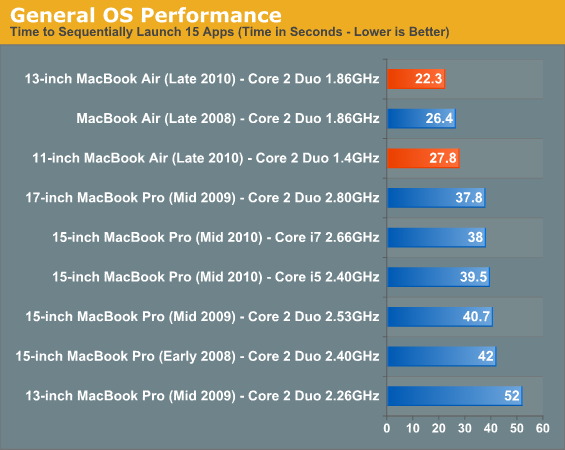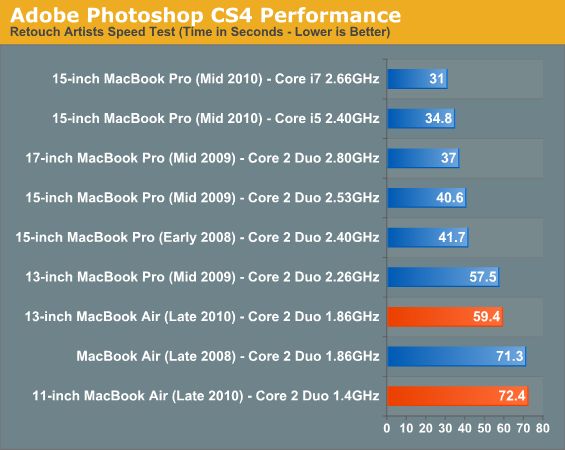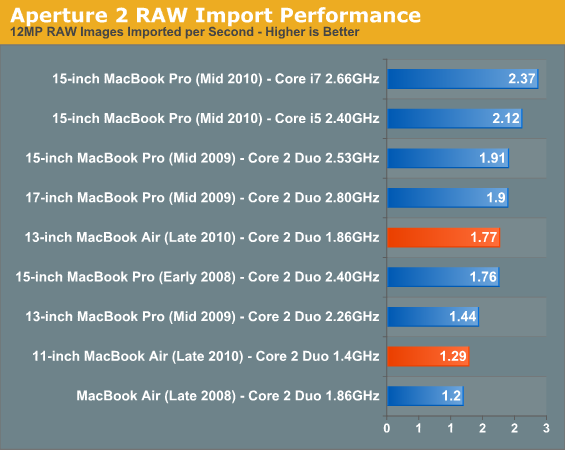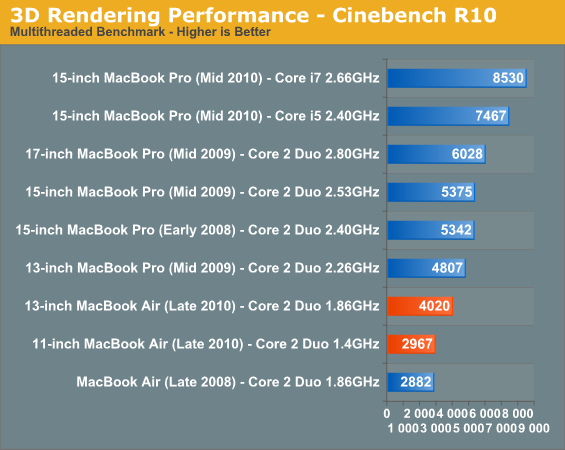Apple's 2010 MacBook Air (11 & 13 inch) Thoroughly Reviewed
by Anand Lal Shimpi on October 26, 2010 10:08 PM EST- Posted in
- Mac
- Apple
- MacBook Air
- Laptops
Performance
Benchmarking under OS X isn’t difficult, you just need to get creative. Luckily I’m in dire need of creative outlets so creating OS X benchmarks works for me. I’m using the same tests I introduced in my Holiday 2009 Macbook Pro roundup and running on the launch hardware for each notebook listed in the charts.
We’ll start with general application performance.
General OS usage is a difficult thing to quantify, but one measure of performance has always been the number of bounces an icon in the dock makes before an application loads. I decided to take it to the next level and write a quick script to launch 15 applications in a row, timing how long the entire process takes.
I launched, in order: Mail, Safari, Activity Monitor, iTunes, iCal, DVD Player, iPhoto, Photo Booth, Quicktime Player, Disk Utility, Preview, iMovie, Front Row, Garage Band and Aperture.
The entire process stresses both the disk and CPU, which is why we see a huge improvement when going to an SSD as well as differences between CPU speeds.

What a difference an SSD can make. The 13-inch MacBook Air is the fastest standard shipping configuration Apple offers in this benchmark. The fact that there's a measurable difference between the 13-inch and 11-inch models shows you just how slow that 1.4GHz Core 2 really is.
Adobe Photoshop CS4 Performance
The Retouch Artists Speed Test we use for our CPU testing under Windows also works under OS X. We're running the exact same benchmark here, basically performing a bunch of image manipulations and filters and timing the entire process.

The 13-inch MacBook Air performs as well as last year's 13-inch MacBook Pro. But if you plan on doing real work, you'll be hampered by the performance of these systems. Apple really needs to find a way to get an Arrandale or Sandy Bridge into this chassis
Aperture 2 RAW Import
For my Aperture test I simply timed how long it took to import 203 12MP RAW images into the library.

The SSD makes the 13-inch MacBook Air far more competitive than it should be here. It's even faster than a two year old 15-inch MacBook Pro. The 11-inch MBA is faster than the old 13-inch MBA due to its better thermal characteristics as we pointed out earlier.
Cinebench R10
I’m a fan of the Cinebench test because it lets me show off both single and multithreaded performance in the same workload. First, the single threaded performance:


The performance in both of these tests in line with the rest of the results. These notebooks aren't very good at intensive workloads. It is worth pointing out that the 13-inch MacBook Air posts better numbers here than the old dual processor 2.5GHz PowerMac G5 :)
Quicktime H.264 Video Encoding
Our final benchmark is more consumer focused. Here I'm taking an XviD and converting it to an iPhone-supported H.264 format.











185 Comments
View All Comments
dsee15 - Wednesday, October 27, 2010 - link
Great thanks. Until then as a technical site, does anyone have a sense what the faster proc and additional 2GB mem do to performance? For example, it should run 20% faster for cpu intense apps, etc.Shadowmaster625 - Wednesday, October 27, 2010 - link
Well if you're spending money on any of these crapple concraptions then you are either not being productive or simply getting paid too much. Like those retired public employees who get paid 6 figure pensions for doing nothing. I dont know when that crap will stop, but I imagine it will be at around the same time apple flirts with bankruptcy.michael2k - Wednesday, October 27, 2010 - link
They have more cash than Microsoft. So after Microsoft flirts with bankruptcy?Shadowmaster625 - Wednesday, October 27, 2010 - link
They do have a lot of cash. But I can easily see them burning up half of it buying back their own stock once it starts tanking. And the other half could be burned up by just one or two flops. And that can easily happen once most apple lovers realize we are in fact in a depression and there is just no place for a company like apple in a depression.ShepherdH - Wednesday, October 27, 2010 - link
they just gave you more RAM and a larger hard drive at them. Same with most other Apple products.iwodo - Wednesday, October 27, 2010 - link
When Apple gets SandyBridge, i suspect 32nm, SandyBridge 1.8Ghz could do so within the same 1.4Ghz C2D Power envelop. But will be much more powerful. The only trouble is Apple wants CPU to be CPU, not a CPU with GPU built in.khimera2000 - Wednesday, October 27, 2010 - link
im not sure about that. they might just be looking for a sweet spot with CPU and GPU performance. in which case AMD's APU chips should be an intresting prospect since it gives you modern architecture on both sides in one chip.where intel took two dies and just slaped them together,AMD made it so the CPU and GPU can actualy talk to each other, also if AMD is to be beleaved this core would be retasked in the presance of another AMD card so the video chip on the CPU dosent become dead weight like the intel solution which just shuts down entirely in the presence of another card. (at least thats what i read)
personaly i think apple should get back into building there own hardware just like the g4 days. but that would require building there own OS, and seeing as mac hasent built an OS from the ground up for a long time (last time being os9? check out something called OpenStep) it might not be in there best intrest with win 7 getting so much traction and the failings of there previous Operating Systems it might not be good for the company to build something there not good at creating.
khimera2000 - Wednesday, October 27, 2010 - link
actually i dont think thats the case. there looking for a balanced system, and to this day intel has not released anything that can run a modern title (that i know of) if intel had a half way descent architecture on there vid cards i could see apple using it.however as things stand intel does not have a descent processer, and thats the reason why they have to use an nvidia video card. being that these notebooks use intergrated memory i can see that apple is looking for a specific perfomance point for there systems.
with that in mind i dont see why they wouldent consider AMD's soon to releas offerings. these chips has better gpu/cpu intergration then intel's options and sports the latest DX11 video architecture AMD has. I dont think theres anything in intel's arsinal that would be able to but heads with these chips from a graphic stand point, the only rogue facter in this is the new CPU architecture, since it has to yet be released.
Speaking of which... when can we expect to see reviews of the amd APU offerings from Anand? i would love to see how well it ticks, and a review to better define what makes it so differant from the intel chips that are comming out... perhaps an architetual comparison sometime in the future???
khimera2000 - Wednesday, October 27, 2010 - link
wow... i didnt know my first post went through for this response.. sorry about that. my connection hickuped. Love the sight keep up the good work :Dblufire - Wednesday, October 27, 2010 - link
You stated that the software restore drive is not write-protected, but Apple states that it is read-only. Who's right?http://support.apple.com/kb/HT4399
Thanks for the review!